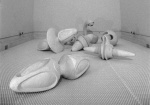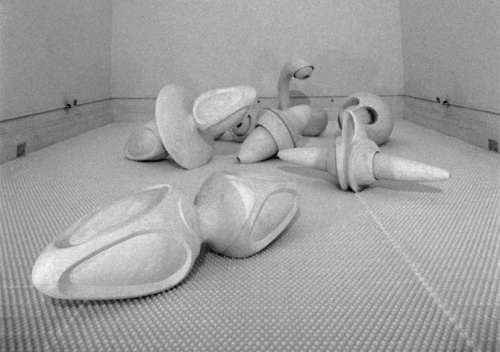 Zellseelen – Seelenzellen, 1997; plaster; 7 parts; Theseustempel, Vienna
Zellseelen – Seelenzellen, 1997; plaster; 7 parts; Theseustempel, Vienna
Photo: Marianne Greber
Zellseelen – Seelenzellen
(Soul cells – Cell souls) , Theseustempel, Vienna, 1997
Zellseelen – Seelenzellen (Soul cells – Cell souls)
Jeanne Silverthorn
The title of Julie Haywards exhibition "Zellseelen – Seelenzellen" (Soul Cells – Cell souls) reflects both a mystical/transcendental and a biological/materialist bent. Alabaster forms constitute a universe of eyeballs eyeballing the universe – a mutual gaze. For a change, the art object looks back. Sentient stalks regard us as steadily as extra-terrestrials making first contact. And if they suggest science fiction, there is now a history to the futuristic which shows that our imagination of the outer worlds is based on what we know of inner worlds – of internal organs, of the microscope. On the one hand, Hayward’s staging of the world as filled with eyeballs functions as a kind of objective correlative for vision itself, and, perhaps, for the Romantics’ conflation of eye/I, certainly for the eye as the window of the soul. On the other hand, it clings to the traditional connection between seeing and proof: as Henry Zerner, discussing Leonardo da Vinci’s conviction that vision is a tool of knowledge remarks: "Between the sixteenth century and the nineteenth, the development of science was intimately linked to vision, because the visible could efficiently be recorded."
Indeed, Hayward reveals that the title of her exhibition is taken from a book by Ernst Haeckel, a turn-of-the-century biologist and philosopher who was the first to study plankton under a microscope and make beautiful drawings of the structures. In these, Hayward discovered shapes similar to her sculptures. "So I thought maybe these shapes have something to do with what we know about. It is like discovering something which is already there and which, at a certain level of concentration, takes shape in the mind." Summarising the ideas of another philosopher, Jean Gebser, she says, "Everything is there already ... and it is found – development going backwards to the origin." Haeckel was also a monist, believing that the soul is organic, developing with the one and only cell. All this is reminiscent of the medieval Modistae, grammarians who, according to Umberto Eco, "asserted the existence of linguistic universals," a belief that Dante, among others, connected with the disappearance of a perfect language after Babel, a perfect language which reflected "the true essence of things." What was left after Babel? Shattered and imperfect forms of locution. To some extent, Hayward’s discourse suggests a similar search for a common (visual not verbal) language that once existed and that expresses the essence of things. From that perspective, there’s a wistfulness about these fragile ovoids scattered about the floor – a hint of Humpty Dumpty.
But the yearning may have more to do with straining toward comprehension, better understanding of an intuition, than simple nostalgia. (After all, as Eco notes, Chomsky’s extremly secular "generative grammar" comes indirectly out of the spiritually inflected thinking of the modistae.) Hayward again: "Within my forms one can see ... two shapes being connected ... a kind of energy field seems to surround them and they get pulled to each other ... but they never really fuse ... they get drawn away again." This Mobius strip of relation and differentiation is fundamentally organic and social. Hayward connects it to Henemann’s comments in "Media Culture and Myths: Regressive Tendencies in the Progress of modern Times": "Evolution is ... a process which transforms and transcends itself ... which follows time and therefore is irreversible ... which in its course brings variety, more complex organization ... which brings higher levels of consciousness ... which brings increasing conscience."
Ultimately, whether retrospective, introspective, or prospective, Hayward’s attempt "to part the united, to unite the parted," as Goethe puts it, is "the life of nature, the breathing in and out of the world in which we live, weave and exist."
Published on the occasion of:
Zellseelen – Seelenzellen, exhibition at Theseustempel, Vienna, 1997
Jeanne Silverthorn
The title of Julie Haywards exhibition "Zellseelen – Seelenzellen" (Soul Cells – Cell souls) reflects both a mystical/transcendental and a biological/materialist bent. Alabaster forms constitute a universe of eyeballs eyeballing the universe – a mutual gaze. For a change, the art object looks back. Sentient stalks regard us as steadily as extra-terrestrials making first contact. And if they suggest science fiction, there is now a history to the futuristic which shows that our imagination of the outer worlds is based on what we know of inner worlds – of internal organs, of the microscope. On the one hand, Hayward’s staging of the world as filled with eyeballs functions as a kind of objective correlative for vision itself, and, perhaps, for the Romantics’ conflation of eye/I, certainly for the eye as the window of the soul. On the other hand, it clings to the traditional connection between seeing and proof: as Henry Zerner, discussing Leonardo da Vinci’s conviction that vision is a tool of knowledge remarks: "Between the sixteenth century and the nineteenth, the development of science was intimately linked to vision, because the visible could efficiently be recorded."
Indeed, Hayward reveals that the title of her exhibition is taken from a book by Ernst Haeckel, a turn-of-the-century biologist and philosopher who was the first to study plankton under a microscope and make beautiful drawings of the structures. In these, Hayward discovered shapes similar to her sculptures. "So I thought maybe these shapes have something to do with what we know about. It is like discovering something which is already there and which, at a certain level of concentration, takes shape in the mind." Summarising the ideas of another philosopher, Jean Gebser, she says, "Everything is there already ... and it is found – development going backwards to the origin." Haeckel was also a monist, believing that the soul is organic, developing with the one and only cell. All this is reminiscent of the medieval Modistae, grammarians who, according to Umberto Eco, "asserted the existence of linguistic universals," a belief that Dante, among others, connected with the disappearance of a perfect language after Babel, a perfect language which reflected "the true essence of things." What was left after Babel? Shattered and imperfect forms of locution. To some extent, Hayward’s discourse suggests a similar search for a common (visual not verbal) language that once existed and that expresses the essence of things. From that perspective, there’s a wistfulness about these fragile ovoids scattered about the floor – a hint of Humpty Dumpty.
But the yearning may have more to do with straining toward comprehension, better understanding of an intuition, than simple nostalgia. (After all, as Eco notes, Chomsky’s extremly secular "generative grammar" comes indirectly out of the spiritually inflected thinking of the modistae.) Hayward again: "Within my forms one can see ... two shapes being connected ... a kind of energy field seems to surround them and they get pulled to each other ... but they never really fuse ... they get drawn away again." This Mobius strip of relation and differentiation is fundamentally organic and social. Hayward connects it to Henemann’s comments in "Media Culture and Myths: Regressive Tendencies in the Progress of modern Times": "Evolution is ... a process which transforms and transcends itself ... which follows time and therefore is irreversible ... which in its course brings variety, more complex organization ... which brings higher levels of consciousness ... which brings increasing conscience."
Ultimately, whether retrospective, introspective, or prospective, Hayward’s attempt "to part the united, to unite the parted," as Goethe puts it, is "the life of nature, the breathing in and out of the world in which we live, weave and exist."
Published on the occasion of:
Zellseelen – Seelenzellen, exhibition at Theseustempel, Vienna, 1997
